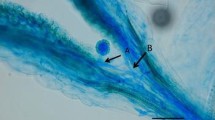Abstract
Seven populations of the selfer Triticum longissimum (= Aegilops longissima) and five populations of the closely related outbreeder T. speltoides (= Ae. speltoides) were scored for chiasma frequencies in pollen mother cells. The populations of the selfer have significantly higher frequencies of chiasmata than the outbreeding populations. This difference becomes even clearer when interstitial chiasmata alone are compared. It is argued that an optimal degree of effective recombination is achieved by the balance between outbreeding and interstitial chiasmata. — There are wider differences between the selfing populations than between the outbreeding populations, but the differences between families (within populations) are small in both species. Variation between plants within families seems to be lower in the selfer, but nevertheless high enough to be inexplicable on the basis of selfing alone. — Small populations subject to hardship conditions show a higher frequency of chiasmata than others.
Similar content being viewed by others
References
Darlington, C. D.: Evolution of genetic systems. Edinburgh: Oliver and Boyd 1939.
Darlington, C. D.: Natural populations and the breakdown of classical genetics. Proc. roy. Soc. (Lond.) B 145, 350–364 (1956).
Darlington, C. D., LaCour, L. F.: The handling of chromosomes, 4th ed. London: Unwin 1962.
Grant, V.: The regulation of recombination in plants. Cold Spr. Harb. Symp. quant. Biol. 23, 337–363 (1958).
Hewitt, G. M.: Population cytology of British grasshoppers. I. Chiasma variation in Chorthippus brunneus, Chorthippus parallelus and Omocestus viridulus. Chromosoma (Berl.) 15, 212–230 (1964).
Hewitt, G. M.: Population cytology of British grasshoppers. II. Annual variation in chiasma frequency. Chromosoma (Berl.) 16, 579–600 (1965).
Hillel, J., Feldman, M. W., Simchen, G.: Mating systems and population structure in two closely related species of the wheat group. I. Variation between and within populations. Heredity 27 (in press, 1972).
Rees, H.: Genotypic control of chromosome from and behaviour. Bot. Rev. 27, 288–318 (1961).
Rees, H., Jones, G. H.: Chromosome evolution in Lolium. Heredity 22, 1–18 (1967).
Simchen, G., Zarchi, Y., Hillel, J.: Supernumerary chromosomes in the second outbreeding species of the wheat group. Chromosoma (Berl.) 38, 63–69 (1971).
Ved Brat, S.: Genetic systems in Allium. III. Meiosis and breeding systems. Heredity 20, 325–339 (1965).
Whitehouse, H. L. K.: Towards an understanding of the mechanism of heredity, 2nd ed. London: Edward Arnold 1969.
Zohary, D., Imber, D.: Genetic dimorphism in fruit-types in Aegilops speltoides. Heredity 18, 223–231 (1963).
Author information
Authors and Affiliations
Rights and permissions
About this article
Cite this article
Zarchi, Y., Simchen, G., Hillel, J. et al. Chiasmata and the breeding system in wild populations of diploid wheats. Chromosoma 38, 77–94 (1972). https://doi.org/10.1007/BF00319956
Received:
Issue Date:
DOI: https://doi.org/10.1007/BF00319956




